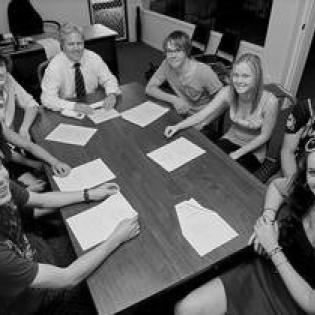Philanthropy in Children's Literature
Read and compare a variety of literature to explore motivations and impact of young people taking action and helping others. We recognize that we all have time, treasures and/or talents to share.
- Listen to a collection of stories about philanthropic acts.
- Identify community needs and brainstorm possible service action.
Choose books that have a philanthropic theme. View options in Learning to Give's Literature Guides
Talk with family tonight about ways they give and take action in the community and world with their time, talent, or treasure.
- Brisson, Pat. Wanda’s Roses
- Cooney, Barbara. Miss Rumphius
- Demuth, Patricia. Johnny Appleseed
- DiSalvo-Ryan, Dyanne. Uncle Willie and the Soup Kitchen
- Lewis, Barbara A., Kid’s Guide To Social Action
Instructions
Ask participants to say the word philanthropy. Break it into syllables and have one-fourth of the group say one syllable in turn. Try this Philanthropy Cheer. Define philanthropy as giving time, talent, or treasure for the common good (the good of everyone).
Explain that the common good is a Core Democratic Value, which means that it is our right and responsibility as a citizen of this country to do things for the good of everyone.
Read aloud a picture book and ask participants to listen for the acts of philanthropy. Learning to Give has an excellent set of literature guides with books that have philanthropy themes. Choose one or more titles to generate discussion and empower them to do something.
After reading the book, have groups discuss how a character acted philanthropically in their community. Then call individuals to report for their group. Record their responses on a chart (See handout below: How Have They Helped?). Add to this chart as you read other books in which listeners identify this theme. Reflect on whether this is a common theme.
Brainstorm a brief list of ideas of things young people can do for the common good (share, listen to others, pick up trash, teach other people). Say, "Keep thinking about problems or needs you see at school, with your families, and in the community. If you see a need, add it to this list. Together we may be able to think of creative ways to make it a little better with our time."
Encourage participants to talk about this with their families. They can define philanthropy and ask family members about ways they act philanthropically. They can come back with more ideas of issues and ways to take action.
Handouts
Philanthropy Framework
-
Strand PHIL.I Definitions of Philanthropy
-
Standard DP 01. Define Philanthropy
-
Benchmark E.1 Define philanthropy as the giving and sharing of time, talent, or treasure intended for the common good.
-
-
Standard DP 04. Operational Characteristics of Nonprofit Organizations
-
Benchmark E.3 Describe how a volunteer youth club in the community operates.
-
-
